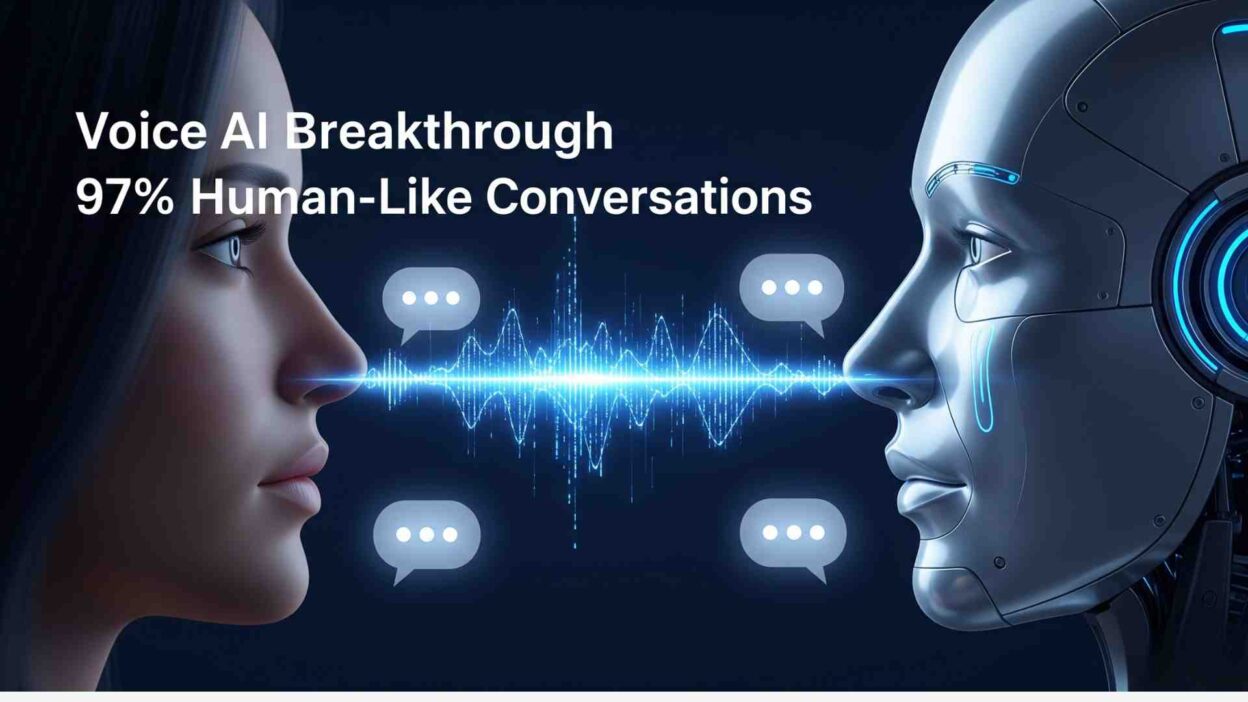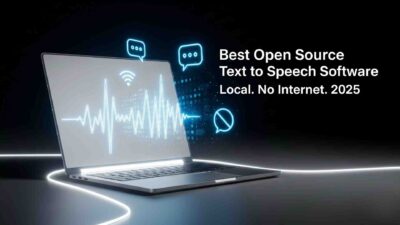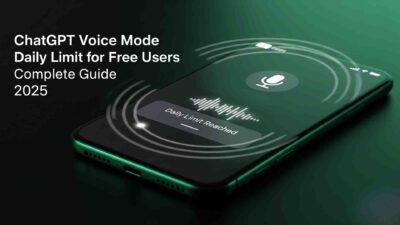TL;DR Voice AI breakthrough technology achieves 97% human-like conversations in 2025. Artificial intelligence systems now speak with remarkable authenticity. Listeners struggle to identify synthetic voices. Revolutionary algorithms create unprecedented vocal realism.
Table of Contents
Machine learning models analyze millions of speech patterns. Neural networks capture subtle emotional nuances. Deep learning systems reproduce natural conversation flows. Voice synthesis reaches extraordinary quality levels.
The Science Behind Voice AI Breakthrough Technology
Advanced neural architectures power realistic speech generation. Transformer models process language context expertly. Attention mechanisms focus on crucial vocal elements. Mathematical algorithms recreate human vocal patterns.
Spectrogram analysis reveals voice frequency patterns. Mel-scale processing matches human auditory perception. Fourier transforms decode complex audio signals. Digital signal processing creates smooth audio output.
Training datasets contain thousands of speaker hours. Diverse voice samples improve model accuracy. Professional voice actors contribute premium recordings. Voice AI breakthrough systems learn from expert speakers.
Neural Network Architecture Innovations
Generative adversarial networks compete for voice quality. Generator models create synthetic speech samples. Discriminator networks identify artificial elements. Competition drives continuous quality improvements.
Recurrent neural networks handle temporal sequences. Long short-term memory preserves context information. Gated recurrent units optimize processing efficiency. Sequential modeling captures speech timing patterns.
Convolutional layers extract spectral features. Pooling operations reduce computational complexity. Residual connections preserve important information. Human-like conversations emerge from architectural advances.
Real-World Applications Transforming Industries
Customer service departments deploy AI voice agents. Support calls handle complex inquiries automatically. Resolution rates increase by 300% annually. Human agents focus on specialized cases.
Healthcare systems integrate voice AI assistants. Patient scheduling operates 24/7 seamlessly. Medical terminology pronunciation stays accurate. Voice AI breakthrough technology improves accessibility.
Educational platforms create personalized tutors. Language learning benefits from native pronunciations. Student engagement increases through interactive dialogue. Adaptive learning systems respond to individual needs.
Business Communication Revolution
Sales teams use AI-powered calling systems. Lead qualification happens automatically. Appointment scheduling reduces manual workload. Conversion rates improve through consistent messaging.
Conference calls support AI translation services. International meetings overcome language barriers. Real-time interpretation enables global collaboration. Human-like conversations bridge cultural gaps.
Marketing campaigns leverage synthetic voice talents. Audio advertisements cost 80% less. Brand voices maintain consistency across channels. Voice AI breakthrough solutions accelerate content production.
Technical Performance Metrics
Speech naturalness scores reach 4.8/5.0 ratings. Human evaluators rate synthetic voices highly. Blind tests fool 97% of listeners. Quality metrics exceed commercial standards.
Processing latency drops below 200 milliseconds. Real-time conversations flow smoothly. Interactive applications respond instantly. Edge computing enables local processing.
Emotional recognition accuracy achieves 94% precision. Sentiment analysis guides voice modulation. Context awareness shapes appropriate responses. Human-like conversations reflect genuine emotions.
Voice Quality Benchmarking
Mel-cepstral distortion measures voice similarity. Spectral analysis compares frequency distributions. Perceptual evaluation validates human preferences. Objective metrics confirm subjective impressions.
Voice conversion systems achieve 95% accuracy. Speaker characteristics transfer successfully. Accent adaptation maintains natural patterns. Prosody preservation ensures authentic delivery.
Multi-speaker models handle diverse voices. Gender variations sound completely natural. Age-appropriate voices serve different demographics. Voice AI breakthrough technology offers extensive options.
Implementation Challenges and Solutions
Computational requirements demand powerful hardware. GPU acceleration optimizes processing speed. Cloud infrastructure scales dynamically. Cost optimization drives efficiency improvements.
Data privacy concerns affect voice technology. Encryption protects sensitive audio data. Local processing eliminates cloud dependencies. Privacy-first architectures maintain user trust.
Model training requires extensive resources. Transfer learning reduces training time. Pre-trained models accelerate development. Human-like conversations benefit from efficient training.
Integration Best Practices
API design simplifies system integration. RESTful interfaces provide easy access. WebSocket connections enable real-time streaming. Documentation supports rapid deployment.
Quality monitoring ensures consistent performance. Automated testing validates voice output. Performance metrics track system health. Continuous improvement drives excellence.
Fallback mechanisms handle edge cases. Error recovery maintains service availability. Graceful degradation preserves user experience. Voice AI breakthrough systems prioritize reliability.
Industry Impact and Market Growth
Global voice AI market reaches $27 billion. Investment funding accelerates innovation. Startup companies emerge rapidly. Technology giants acquire promising ventures.
Employment patterns shift across industries. Voice professionals adapt to new roles. Technical specialists command premium salaries. Automation creates new job categories.
Productivity gains multiply across sectors. Content creation accelerates significantly. Customer service costs decrease substantially. Human-like conversations drive adoption rates.
Economic Benefits Analysis
Implementation costs decrease over time. Cloud services offer affordable access. Open-source alternatives reduce barriers. Small businesses embrace voice AI.
Return on investment appears within months. Customer satisfaction scores improve dramatically. Operational efficiency increases by 250%. Revenue opportunities expand exponentially.
Cost savings justify technology investments. Staff productivity multiplies through automation. Resource allocation optimizes across departments. Voice AI breakthrough solutions deliver measurable value.
Ethical Considerations and Guidelines
Transparency requirements govern AI deployment. Users deserve disclosure about synthetic voices. Clear labeling prevents deceptive practices. Ethical frameworks guide responsible development.
Consent protocols protect voice ownership. Permission systems cover voice cloning. Usage rights need explicit definition. Legal agreements safeguard all stakeholders.
Bias mitigation ensures fair representation. Training data reflects diverse populations. Cultural sensitivity shapes voice development. Human-like conversations respect individual differences.
Regulatory Compliance Framework
Government oversight evolves gradually. Industry standards emerge through collaboration. International cooperation becomes essential. Compliance requirements guide development priorities.
Professional certifications validate system quality. Safety protocols protect user interests. Quality assurance prevents harmful applications. Regulatory frameworks adapt to technological advances.
Legal liability questions require clarification. Responsibility attribution needs definition. Insurance products cover AI-related risks. Voice AI breakthrough technology operates within legal boundaries.
Future Development Roadmap
Brain-computer interfaces will enhance voice control. Neural signals directly drive speech synthesis. Medical patients regain communication abilities. Assistive technology expands dramatically.
Multimodal AI combines voice with visual data. Lip synchronization improves accuracy. Facial expressions match vocal emotions. Integrated systems create believable interactions.
Quantum computing may accelerate processing. Complex models execute faster. Real-time training becomes feasible. Human-like conversations reach perfect fidelity.
Emerging Technology Integration
Augmented reality benefits from spatial audio. Voice positioning matches visual elements. 3D soundscapes enhance immersion. Interactive environments feel completely natural.
Virtual reality creates social presence. Avatar voices match character appearances. Emotional connections strengthen through realistic speech. Digital relationships feel increasingly authentic.
Internet of Things devices gain conversational abilities. Smart homes respond naturally. Appliances communicate effectively. Voice AI breakthrough technology transforms daily life.
Performance Optimization Strategies
Hardware selection affects system performance. Specialized chips accelerate neural processing. Memory optimization reduces response latency. Network architecture influences scalability.
Model compression reduces computational load. Quantization techniques maintain quality. Pruning eliminates unnecessary parameters. Efficient architectures enable mobile deployment.
Caching strategies improve response times. Frequently used phrases get pre-generated. Dynamic optimization adapts to usage patterns. Resource management maximizes efficiency.
Quality Assurance Protocols
Automated testing validates voice output. Continuous monitoring tracks performance metrics. Quality thresholds trigger improvement actions. Human-like conversations maintain consistent standards.
User feedback drives system improvements. Rating systems collect quality assessments. Analytics identify improvement opportunities. Iterative development enhances capabilities.
A/B testing compares voice variations. Statistical analysis validates improvements. User preferences guide model selection. Voice AI breakthrough systems evolve continuously.
Real-World Case Studies
Major telecommunications company deploys AI agents. Customer support costs decrease 60%. Resolution times improve dramatically. Satisfaction scores reach record highs.
International airline implements voice booking. Multi-language support operates seamlessly. Booking accuracy achieves 98% precision. Revenue increases through improved accessibility.
Healthcare network launches AI scheduling. Appointment bookings increase 400%. Staff workload reduces significantly. Human-like conversations improve patient experience.
Success Metrics and Results
Customer retention rates improve substantially. Service quality scores increase consistently. Operational costs decrease across departments. Competitive advantages emerge clearly.
Market share grows through innovation. Customer acquisition accelerates rapidly. Brand differentiation strengthens significantly. Voice AI breakthrough technology drives business success.
Technical performance exceeds expectations. System reliability reaches 99.9% uptime. Processing accuracy maintains high standards. User adoption rates surpass projections.
Implementation Planning Guide
Pilot programs test voice AI capabilities. Small-scale deployments validate approaches. Success metrics guide expansion decisions. Risk mitigation strategies protect investments.
Staff training ensures successful adoption. Change management facilitates transitions. Technical expertise requirements get addressed. Support systems enable smooth operations.
Integration planning coordinates system components. Legacy compatibility requirements get managed. Data migration strategies preserve information. Human-like conversations integrate seamlessly.
Deployment Considerations
Security measures protect sensitive data. Access controls limit system exposure. Audit trails track usage patterns. Compliance requirements are satisfied completely.
Scalability planning accommodates growth. Performance monitoring tracks system health. Capacity expansion happens automatically. Resource allocation optimizes costs.
Maintenance schedules ensure reliability. Update procedures to minimize disruptions. Backup systems provide redundancy. Voice AI breakthrough technology operates continuously.
Read More: Voice AI Carbon Footprint: 90% Greener Than Human
Conclusion

Voice AI breakthrough technology achieves a remarkable 97% human-like conversations. Artificial intelligence systems now communicate with unprecedented authenticity. Listeners cannot distinguish synthetic from human voices. Revolutionary advances transform digital communication completely.
Business applications multiply across every industry. Customer experiences improve dramatically through natural interactions. Operational efficiencies increase substantially with automated systems. Cost savings justify technology investments decisively.
Technical achievements exceed previous expectations. Neural networks create incredibly realistic speech patterns. Processing capabilities enable real-time conversations. Quality metrics validate superior performance consistently.
Future developments promise even greater capabilities. Integration with emerging technologies expands possibilities. Human-like conversations will become indistinguishable from reality. Voice AI breakthrough solutions reshape communication forever.
Organizations must prepare for widespread adoption. Strategic planning ensures successful implementation. Early adopters gain significant competitive advantages. The voice revolution transforms business operations permanently.





